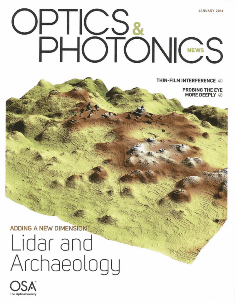Drs. Chase Use “Super X-Ray Vision” With Lidar
Congratulations to Drs. Arlen, Diane Chase and John Weishampel, for their laser scan of Caana, Caracol’s main architectural complex in Belize, making the cover of the Optics and Photonics News magazine’s January 2014 issue!
Drs. Arlen and Diane Chase, and Dr. John Weishampel, were recently interviewed by Patricia Daukantas for Optics and Photonics News about their use of Lidar, a laser using a mixture of light and radar, in mapping out Caracol. “Lidar and Archaeology: Adding a New Dimension” examines the evolution of Lidar and the applications of it within archaeology. The article states that archaeologists who have worked with the technology say Lidar is “bringing about a paradigm shift in studies of Mesoamerica.” While Dr. Arlen Chase agrees Lidar has allowed for a better study of space, he still believes excavations are necessary to fully interpret time. You can read the article on their Caracol website. Or, for a limited time, read the whole magazine on the Optics and Photonics News magazine page.
Dr. Arlen F. Chase is Associate Dean of the College of Sciences and Chair of the Department of Anthropology and a Pegasus Professor, specializing in anthropological archaeology. His primary focus of research is on the ancient Maya of Central America. He received his B.A. in 1975 and his Ph.D. in 1983 in anthropology from the University of Pennsylvania. His research interests focus on archaeological method and theory in the Maya area with particular emphasis on contextual, settlement, and ceramic analysis and secondary interests on urbanism, ethnicity, and epigraphic interpretation. He has been at UCF since 1984 and teaches: Archaeology and the Rise of Human Culture, Mesoamerican Archaeology, Archaeological Method and Theory, The Ancient Maya, Maya Hieroglyphic Writing, and field courses in Belize.
Dr. Diane Z. Chase is Executive Vice Provost and a Pegasus Professor. She specializes in anthropological archaeology with a primary research focus on the ancient Maya in Central America. She received her B.A. in 1975 and her Ph.D. in 1982 in anthropology from the University of Pennsylvania. Her research interests focus on archaeological method and theory in the Maya area with a particular emphasis on the rise and fall of complex societies, osteological and mortuary analysis, and ethnohistory.
Dr. John Weishampel is a Professor in the Department of Biology. Dr. Weishampel’s primary research interest is in the field of landscape ecology, i.e., how landscape pattern influences ecological processes and biodiversity. Using simulation models coupled with field observations, he explores how the interplay between abiotic conditions (e.g., habitat structure, natural and anthropogenic disturbance regimes) and biotic processes (e.g., competition, dispersal, growth, succession) governs the behavior of plants and animals at landscape scales. One emphasis of his research is to use models, interfaced with remote sensing (from satellite and airborne instruments) and geographic information systems (GIS), to explore spatial properties of ecological systems to better understand compositional, structural, and functional biodiversity in terrestrial, freshwater, and marine systems.

